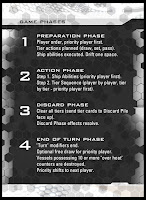Part 4 of this series address mechanical limitation with customizable card games. But there are other aspects of any thinking game that can slow down the experience. What part of a strategy game consumes the most play time (as opposed to preparation time)? After component prep (perhaps painting miniatures or building your deck) and game set up, what takes up the most amount of time during a game is probably either chatting or action planning. You'll have to deal with the dialogue issue on your own. But issues related to over analyzing a turn (known as analysis paralysis) is addressed with the game design of Dog Fight: Starship Edition. Let's take a look.
Sequence of Play
The Tier Sequence is designed to be executed very quickly. The Action Phase occurs in rapid succession so the action of the game keeps a fast pace. The Preparation Phase is where most of the thinking occurs during game play. In test groups this is where most of the talking occurs as well, which makes it easy to get lost as to what is going on in the game (reminder tokens have proven very useful).
In many games the "downtime" that occurs while you wait on another player can be frustrating. Even if the game is fun, this downtime can seriously slow down game pace. Oddly enough, in many strategy games this downtime is not really downtime at all. As with some miniatures games and some other customizable card games, Dog Fight makes good use of it.
With the programming game construct, you will see your opponents prepare their actions for the turn. Though you don't know what cards are being placed on the table, this brief lull in game action can provide invaluable insight into that player's plans for the turn. The priority player actually has a slight disadvantage in this instance. He/she must perform the Preparation Phase before any other player. This means all other players can use this information somewhat like intelligence gathering, and plan their own actions for the turn accordingly (as best as they can guess what the priority player planned to do).
If you mentally check out during this time (or use conversation to your advantage, letting other players distract themselves) players can easily lose track of any tactics they might have wished to play for the turn. You'll find some ideas work best when you have priority, and some work best when you don't. Keeping an eye on the plans of other players can prove very significant during the Action Phase.
Dog Fight: Starship Edition was designed to mitigate analysis paralysis. The game cards are mostly straight forward and rather simple. Because you can use several cards in a turn, and there may be costs associated with those effects, keeping track of everything may burn a few synapses while preparing your actions for the turn. You'll often have to guess as to any opponent actions while preparing your own moves. And if you have Support Craft in the game, that's another dynamic added into the mix. It can be a lot to keep in mind.
The game cards are written so that minimal interpretation should be required. If you read the cards (yes, I have to actually mention that), and if you read them literally, figuring out what to do should be simple enough. Keeping track of it all may not be so easy at first but experience with the game should help a great deal in this regard.
Given the (mostly) simple card effects and the fact that your maximum hand limit is 10 cards, if your deck is designed well you shouldn't have much trouble in deciding what to do for your actions on any given turn. In fact, in my group's testing sessions, the longest games we played included a lot of chit chat as well. The game play itself moves quickly.
In the next installment of this series will be some final thoughts about the theory behind the game and why it was created in the first place.
- Home
- About
- _--The Approach
- _--Insights
- _--FAQ
- _--Reviews
- _--Contact
- The Game
- _--Releases
- _--Game Formats
- _--The Ships
- _--Missions
- _--Restricted List
- _--Tips
- Extras
- _--Accessories
- _--Videos
- _--Downloads
- _--Ship Calculators
- _--Game Lore
- _--The Code
- News
- _--Newsletter
- The Tribe
- _--Forums
- _--Friends
- _--The Artists
- Shopping Cart
- _--Ordering
- Card Database





0 Comments